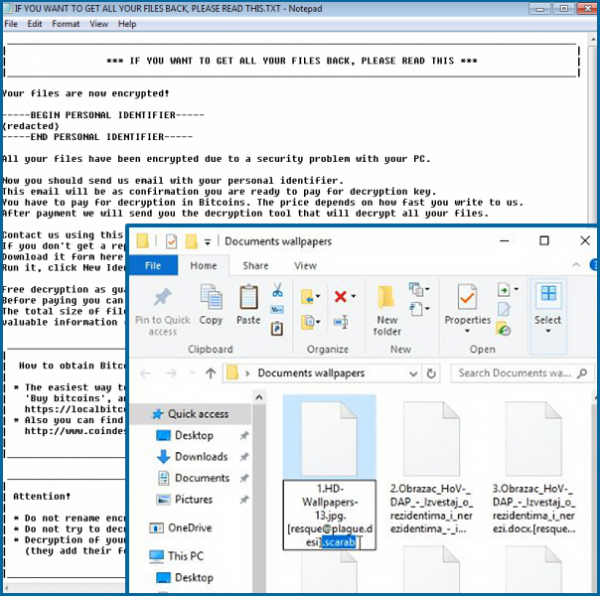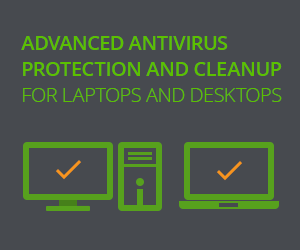Breaking into malware news this week is the re-emergence of Scarab ransomware. The blackmail malware under review is built on the basis of Hidden-Tear ransomware project code but has many new features and improvements.

The noteworthy element of the Scarab ransomware outbreak is its use of the Necurs botnet. The latter is quite remarkable as it once utilized to deliver the infamous Locky ransomware.
Malware analysts do not think that the Necurs botnet gang created this virus. Another group just rented the botnet.
Huge amounts of spam email are being dispersed every hour masked as scanned copier messages with malicious 7z archives attached. Hackers have sent 13 million emails total this week.
Once inattentive users click and open the attachment, the rogue script begins to download and install Scarab ransomware. It begins to scan files and encrypt them afterward. All locked files get the .scarab extension as a lineament. In addition, each file name includes the contact email address. Most often addresses are:
[email protected]
unlocking@[email protected]
[email protected]
[email protected]
[email protected]
To inform victims of their unenviable position Scarab ransomware creates a ransom note which it drops in every folder where encrypted files lie. The ransom note is named: “IF YOU WANT TO GET ALL YOUR FILES BACK, PLEASE READ THIS.TXT”.
Unlike other extortion viruses, Scarab does not state the ransom amount. However, hackers stress that the quicker victims get in touch, the less they would have to pay.
Removing the virus is not a problem but infected users face hard times unlocking their files. In most cases they fail because Scarab deletes the shadow volume copies. Yet others succeed by using data recovery manual methods and software.
The below guide is designed to assist infected users to restore their files.
Automatic removal of Scarab File Virus
The benefits of using the automatic security suite to get rid of this infection are obvious: it scans the entire system and detects all potential fragments of the virus, so you are a few mouse clicks away from a complete fix.
- Download and install recommended malware security suite
- Select Start Computer Scan feature and wait until the utility comes up with the scan report. Proceed by clicking on the Fix Threats button, which will trigger a thorough removal process to address all the malware issues compromising your computer and your privacy.
Restore files locked by Scarab File Virus
new Locky variant aka Scarab File Virus represents a unique category of malicious software whose attack surface reaches beyond the operating system and its components, which is why removing the virus itself is a part of the fix only. As it has been mentioned, it encrypts one’s personal information, so the next phase of the overall remediation presupposes reinstating the files that will otherwise remain inaccessible.
-
Launch data recovery software
Similarly to the rest of its fellow-infections, Scarab File Virus most likely follows an operational algorithm where it erases the original versions of the victim’s files and actually encrypts their copies. This peculiarity might make your day, because forensics-focused applications like Data Recovery Pro are capable of restoring the information that has been removed. As the virus further evolves, its modus operandi may be altered – in the meanwhile, go ahead and try this.
-
Take advantage of Volume Shadow Copy Service
This technique is based on using the native backup functionality that’s shipped with Windows operating system. Also referred to as Volume Snapshot Service (VSS), this feature makes regular backups of the user’s files and keeps their most recent versions as long as System Restore is on. Scarab Virus ransomware hasn’t been found to affect these copies therefore the restoration vector in question is strongly recommended. The two sub-sections below highlight the automatic and manual workflow.
- a) Use Shadow Explorer
Shadow Explorer is an applet that provides an easy way of retrieving previous versions of files and folders. Its pro’s include an intuitive interface where the computer’s entire file hierarchy is displayed within one window. Just pick the hard disk volume, select the object or directory to be restored, right-click on it and choose Export. Follow the app’s prompts to get the job done.

- b) Use file properties
Essentially, what the above-mentioned Shadow Explorer tool does is it automates the process that can otherwise be performed manually via the Properties dialog for individual files. This particular approach is more cumbrous but just as effective as its software-based counterpart, so you can proceed by right-clicking on a specific file, which has been encrypted by Scarab Virus, and selecting Properties in the context menu. The tab named Previous Versions is the next thing to click – it displays available versions of the file by date of the snapshot creation. Pick the latest copy and complete the retrieval by following the prompts.

-
Data backups work wonders
Ransomware like Scarab isn’t nearly as almighty and destructive in case you run regular file backups to the cloud or external data media. The virus itself can be completely removed in a matter of minutes, and the distorted information can then be just as easily recovered from the backup. Luckily, this is a growing trend, so ransom Trojans are hopefully going to become less subversive in the near future.
Verify thoroughness of the removal
Having carried out the instructions above, add a finishing touch to the security procedure by running an additional computer scan to check for residual malware activity
